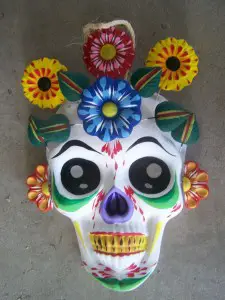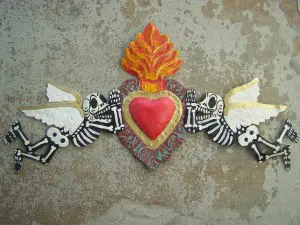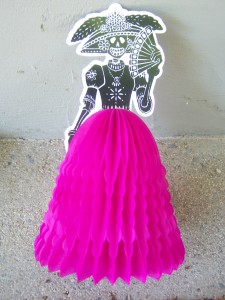Podcast: Play in new window | Download
Subscribe: Apple Podcasts | RSS

This podcast is about Day of the Dead; the back translation in the United States is Dia de los muertos. In Mexico the holiday is called Dia de muertos or Dia de difuntos. It is celebrated in the beginning of November but just because it’s at that time of the year and involves happy skeletons, this holiday has nothing to do with zombie movies, devil worship or voodoo and it is NOT the “Mexican Halloween.” The only thing in common that traditional Day of the Dead has in common with Halloween is that it is syncretic, that is, it blends older pagan beliefs with Christianity. There have been some Halloween elements that have crept into the holiday from the North, but that has only been recent, with the flow of returning migrants and the overpowering nature of American culture in the age of globalization. The podcast will be about the traditional celebrations as found in Mexico and will comment about some of the overflow seen in the United States, especially within the last 20 years.
The original basis of the holiday dates back possibly thousands of years and is rooted in the pre-Hispanic cultures of central and southern Mexico. The Aztecs were the big kids on the block when the Spanish first arrived and throughout their vast empire they honored the goddess Mictecacihuatl, informally known as “Lady Death” at the beginning of the summer. Yes, the celebrations included human sacrifice and individuals constructed altars to honor the dead primarily by giving offerings of skulls made of a mixture of corn meal and animal blood. The Spanish knew they could not wipe out these traditions entirely, so they moved the Lady Death celebration so that it aligned better with the Catholic calendar and thus the new Day of the Dead was born on All Souls Day and All Saints Day. The more indigenous the community, the more of the older traditions were kept. The more European the community, the more traditionally Catholic the celebrations. You can see this to this day throughout central and southern Mexico (It’s important to note how regional the holiday is. The largest states in Mexico – Sonora and Chihuahua – have no history of this holiday because the Aztec Empire did not extend that far north).
So, how is this holiday celebrated? It varies from place to place but there are some common threads and themes. A few days before the holiday people start to build altars or ofrendas in their homes to honor those who have passed. There are a lot of books out now on Day of the Dead and the books usually show elaborate altars that take up most of an entire room that have cost a fortune to build. That’s a little over the top for most people. If you have ever seen an ofrenda, it’s pretty simple and includes some basic elements: a table cloth to make it nice, mementos of loved ones such as personal keepsakes and photos, religious iconography like statues and pictures of the saints or Virgin Mary and flowers. Depending on availability the flowers are usually a Mexican variety of marigold, in the vernacular called cempasúchil or any other flowers that are in season or available. On the two days that make up the holiday incense is burned at the altar, usually from the copal tree, and they say that the incense combined with the smell of the marigolds is supposed to produce a mild “high” in the inhaler. Also closer to the holiday, food is placed on the altar, the favorite foods of the person who has passed. All of this is done so that the deceased will feel welcome enough to return to earth on these few days to be with loved ones.

Day of the Dead is huge for crafts. Nowadays, crafts are plentiful online and are available year-round. Deep in the heart of Mexico, however, the best crafts are made in October, right before the holiday. The crafts are sold to people who are going to use them to decorate their altars or their homes and they come in various forms. Some are long-lasting and some are ephemeral, and only meant to last a few days, like the cut tissue paper strands called papel picado. Clay happy skeleton figures are meant to amuse the spirits, and entertain the living. These crafts take as many forms as anyone can imagine… I have seen everything. Another major craft whipped up right before the holiday is the sugar skull. In Mexico they are made of sugar and egg whites. We use meringue powder here in the US because we are afraid of salmonella poisoning. You can always tell which ones are made with egg whites because they shine. They are not meant to be eaten. They are nice to look at and give off a sweet smell for the spirits. The whole tradition of sugar skulls was introduced to replace the Aztec skulls of cornmeal and blood. Alfeñique is the name of this kind of sugar craft and originated among a religious order in Sicily a few centuries before the Aztec conquest and was brought by the Catholic clergy to Mexico.
 While you are not supposed to eat the sugar skulls – they are as hard as a brick – there are special foods available in the marketplaces that you can actually eat. Chocolate skulls and lollipops are common and they taste just like what modern chocolate tastes like all over. There is also pan de muerto “dead bread” that is served at this time. It’s typical of Mexican pan dulce in that it really isn’t that sweet and it’s not really that distinctive.
While you are not supposed to eat the sugar skulls – they are as hard as a brick – there are special foods available in the marketplaces that you can actually eat. Chocolate skulls and lollipops are common and they taste just like what modern chocolate tastes like all over. There is also pan de muerto “dead bread” that is served at this time. It’s typical of Mexican pan dulce in that it really isn’t that sweet and it’s not really that distinctive.
Depending on where you are, there are usually religious processions that lead to the church and followed by a mass. Many of these religious celebrations are followed by all night vigils in the cemeteries that are often very festive with food, drink and music. As I said before, the celebrations vary depending on where you are. Day of the Dead in Patzcuaro, for example will be different from the same holiday celebrated in Oaxaca or Veracruz.
Day of the Dead celebrations are relatively new in the United States, in fact you would be hard pressed to find any celebration that dates back to before 1995 anywhere, even in the places like the Southwest with large Mexican immigrant or Mexican-American populations.
A lot of the people with roots in the northern states of Mexico who started celebrating the holiday had no family history of celebrating it, and we are talking of hundreds of years of their family being Mexican and no history of celebrating this holiday. The popularity of Day of the Dead has seemed to rise with rise in Latino consciousness that was just taking off in the 1990s as a lot of Latinos were drawn to Day of the Dead as a form of cultural expression.
REFERENCES:
There are too many books and articles to list here. A simple Amazon search will pull up hundreds of titles. Each book pretty much has a background section with longer works going in more detail.
To check out hundreds of different types of crafts for sale, go here: http://stores.ebay.com/suenosimports/Day-of-the-Dead-Crafts-/_i.html?_fsub=18706840
